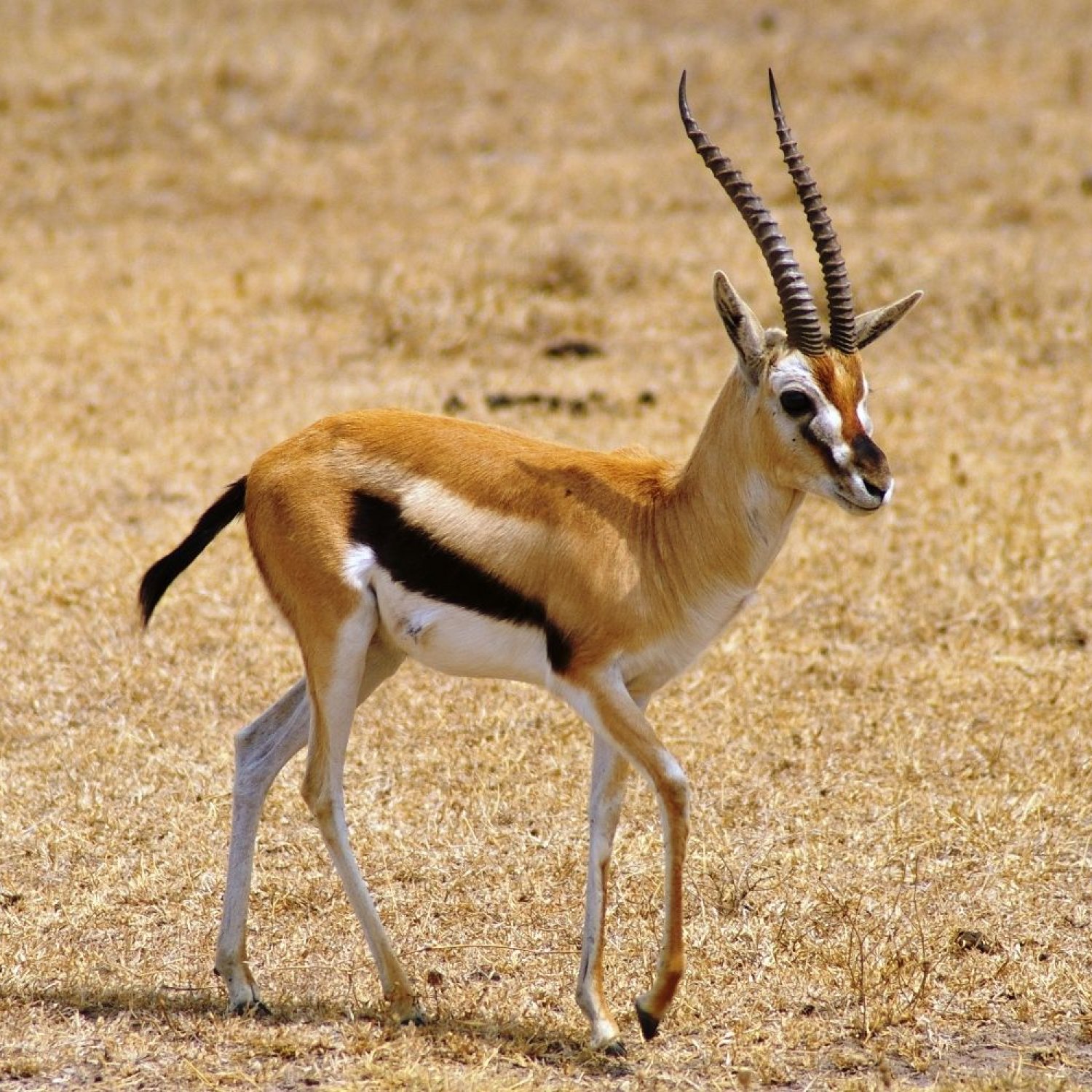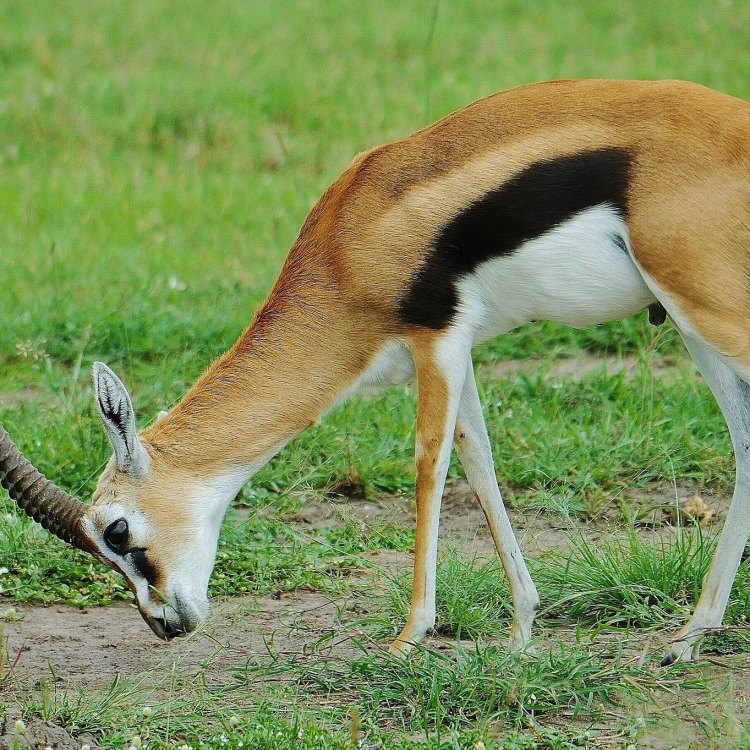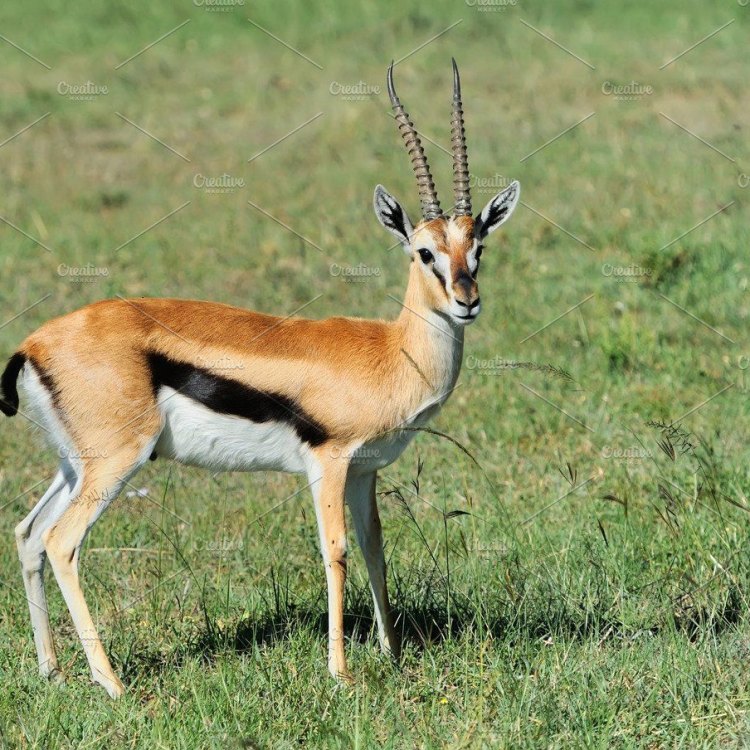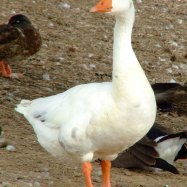
Gazelle
1.2 to 1.8 meters
Gazelles are graceful animals belonging to the Bovidae family. These majestic creatures can be found in various regions of Africa and Asia and are known for their slim and agile body shape. With a length ranging from 1.2 to 1.8 meters, gazelles are a sight to behold in the wild. These herbivores are an important part of their ecosystem, helping to maintain the balance of their habitats. So, keep your eyes peeled on your next safari for a glimpse of these beautiful animals in their natural habitat.
Animal Details Summary:
Common Name: Gazelle
Kingdom: Animalia
Habitat: Grasslands, savannas, and deserts
The Graceful Gazelle: Discover the Alluring Beauty and Surprising Facts of this Magnificent Animal
The vast grasslands and savannas of Africa and parts of Asia are home to a variety of majestic animals, but one stands out for its elegant and slim figure - the Gazelle. These mesmerizing creatures have captivated the hearts of many with their graceful movements and alluring features. In this article, we will delve into the world of the Gazelle, discovering its unique characteristics and surprising facts.A Majestic Species
The Gazelle belongs to the genus Gazella, which consists of about 14 species Gazelle. They are commonly referred to as Gazelles, and their scientific name corresponds to their genus. These beautiful animals belong to the animal kingdom, Phylum Chordata, class Mammalia, order Artiodactyla, and family Bovidae - the same family as goats, sheep, and antelopes.Gazelles are well-known for their slender and agile body structure, which makes them incredibly fast runners. They have long and slender legs, allowing them to reach a speed of up to 60 miles per hour (97 kilometers per hour). These impressive speeds are essential for their survival in the wild, as they need to outrun predators such as cheetahs, lions, and wild dogs.
A Diverse Habitat
Gazelles are found in various regions in Africa and Asia, as their geographical distribution covers multiple countries in these continents. They inhabit areas such as grasslands, savannas, and deserts, making them incredibly adaptable to a diverse range of ecosystems. This adaptability allows them to thrive in different environments, from the Sahara Desert to the Arabian Peninsula.One of the reasons for this diverse distribution is the migration patterns of Gazelles German Wirehaired Pointer. Many species of Gazelles migrate annually, following the rains and moving to areas with more abundant food and water sources. This trait not only aids in their survival but also helps in the distribution of their species across large areas.
A Herbivorous Diet
As members of the Bovidae family, Gazelles are herbivorous animals, meaning they consume a diet mainly consisting of plants. They are known for their selective feeding habits, in which they specifically target certain plants for their nutritional value. Gazelles mainly feed on grasses and leaves, but they have also been observed eating fruits, seeds, and even insects at times.Their feeding method is also linked to their habitat and migration patterns. In areas where food is scarce, Gazelles may have to migrate longer distances to find adequate food sources. They also often graze alongside other herbivores, such as zebras and wildebeests, as this creates a safer environment for them to feed.
The Golden-Brown Beauties
Gazelles have a unique coloration that adds to their mesmerizing beauty. They are often a golden-brown or tan color, with white patches on their belly and legs. These colors not only blend in with their surroundings, but they also play a crucial role in thermoregulation. In hotter climates, their light color reflects the sun's heat, keeping them cooler, while in colder regions, their dark color absorbs heat, keeping them warm.Some species of Gazelles have additional markings, such as stripes or black marks on their faces, adding to their already striking appearance. These markings also aid in camouflaging with their herd, making it challenging for predators to single them out.
A Social Animal
Gazelles are social animals, typically living in herds of 10 to 30 individuals, although herds can range from 3 to 100. These herds consist of a dominant male, a few females, and their offspring. Male Gazelles compete for the dominant position in the herd through ritualistic fights, where they lower their heads and charge at each other. These battles rarely result in serious injuries and serve as a way for males to establish their dominance.Female Gazelles, on the other hand, form strong bonds with other females and their young. They work together to raise their offspring and protect them from predators. Gazelles also practice alloparenting, which means females in the herd will also help care for and protect each other's young.
A Symbol of Beauty and Grace
The Gazelle's graceful movements and elegant features have long made it a symbol of beauty and grace. In ancient Mesopotamian art, Gazelles were depicted as symbols of love and longing. In Greek mythology, the Gazelle represented the goddess Artemis, the goddess of hunting and the wild.The Gazelle has also been a source of inspiration in the world of fashion and design. Its slender figure has inspired clothing designs, and its graceful movements have been mimicked in dance and other forms of art. It continues to be a symbol of beauty and grace in many cultures today.
A Vulnerable Species
Despite their adaptability and impressive survival instincts, Gazelles are currently facing threats in the wild. Some species, such as the Dama Gazelle, are listed as critically endangered by the International Union for Conservation of Nature (IUCN). Others, like the Goitered Gazelle, are considered vulnerable.Habitat loss, caused by human activities such as agriculture and infrastructure development, is one of the main threats to Gazelles. They are also hunted for their meat and hides, and their natural predators, such as cheetahs and wild dogs, are also declining due to habitat loss and poaching. Conservation efforts are being made to protect these beautiful animals, but more needs to be done to ensure their survival in the wild.
An Animal Worth Protecting
The Gazelle may seem like just another beautiful animal in the vast landscape of the African and Asian plains, but it is so much more than that. Its unique characteristics, from its stunning coloration to its swift movements and social behavior, make it a truly remarkable species. Gazelles are not only vital to the ecosystems they inhabit, but they also hold cultural and symbolic significance to many.With their adaptability and survival instincts, Gazelles have managed to thrive in various environments for centuries. But as human activities continue to encroach upon their habitats and threaten their survival, it is crucial to protect and conserve these magnificent creatures. They are not just animals, but an integral part of our natural world, and it is our responsibility to ensure that they continue to grace our landscape for generations to come.

Gazelle
Animal Details Gazelle - Scientific Name: Gazella
- Category: Animals G
- Scientific Name: Gazella
- Common Name: Gazelle
- Kingdom: Animalia
- Phylum: Chordata
- Class: Mammalia
- Order: Artiodactyla
- Family: Bovidae
- Habitat: Grasslands, savannas, and deserts
- Feeding Method: Herbivorous
- Geographical Distribution: Africa and parts of Asia
- Country of Origin: Multiple countries in Africa and Asia
- Location: Various regions in Africa and Asia
- Animal Coloration: Golden-brown or tan
- Body Shape: Slim and agile
- Length: 1.2 to 1.8 meters

Gazelle
- Adult Size: 60 to 110 centimeters at the shoulder
- Average Lifespan: 10 to 12 years
- Reproduction: Sexual
- Reproductive Behavior: Polygynous mating system
- Sound or Call: Gazelles produce various vocalizations
- Migration Pattern: Some gazelle species undertake seasonal migrations
- Social Groups: Form herds or groups
- Behavior: Fast runners and skilled jumpers
- Threats: Habitat loss, hunting, and predation
- Conservation Status: Varies among species (some are endangered)
- Impact on Ecosystem: Important prey species for carnivores
- Human Use: Hunting, ecotourism
- Distinctive Features: Curved horns, large eyes, and long legs
- Interesting Facts: Gazelles are known for their incredible speed and agility
- Predator: Lions, cheetahs, leopards, hyenas, and wild dogs

Gazella
The Graceful Gazelle: A Closer Look at Nature's Fastest Antelope
When we think of the fastest land animals, our minds often go to the mighty cheetah or the swift antelope. But within the antelope family, a smaller and lesser-known species reigns as the true speed champion - the gazelle. These graceful creatures can be found across Africa and parts of Asia, and their unique features and behaviors make them a fascinating subject to explore. Join me as we delve into the world of gazelles and uncover their secrets PeaceOfAnimals.Com.Meet the Gazelle
Gazelles are a group of antelopes that belong to the same scientific genus, Gazella. There are about 19 known species of gazelles, varying in size, color, and habitat. However, they all share some distinctive features that set them apart from other antelope species.The most notable physical feature of gazelles is their long and slender legs, which make them fast runners and skilled jumpers. They can reach speeds of up to 60 miles per hour, making them some of the fastest animals on land. Their large eyes also give them excellent vision, helping them spot potential predators from afar.
On average, gazelles grow to be 60 to 110 centimeters at the shoulder, with males being slightly larger than females. They have a lean and agile build, with short fur that ranges from light brown to a reddish-brown color. Some species also have distinctive white markings on their faces and bodies Giant Salamander.
Life of a Gazelle
The average lifespan of a gazelle is 10 to 12 years, but captive individuals have been known to live up to 18 years. Gazelles have a polygynous mating system, which means one male mates with multiple females. During the mating season, males engage in fierce and sometimes violent battles to establish dominance and acquire a harem of females.Gazelles produce various vocalizations, including a high-pitched whistle, snorts, and grunts. They use these calls to communicate with their herd members, especially during mating or when sensing danger. Interestingly, each species of gazelle has its own unique set of vocalizations.
Some gazelle species undertake seasonal migrations in search of food and water. These long-distance journeys can cover hundreds of miles and are essential for the survival of the species. Gazelles also form herds or groups, usually consisting of a dominant male, a group of females, and their young.
The Gazelle in its Ecosystem
Gazelles play a vital role in their ecosystems, as they are an essential prey species for carnivores. Their sheer speed and agility make them challenging to catch, but they still fall prey to predators such as lions, cheetahs, leopards, hyenas, and wild dogs. Their population numbers also affect the survival of these predators, as a decline in gazelle numbers could have a ripple effect on the entire food chain.Unfortunately, gazelles face several threats in their natural habitats, including habitat loss, hunting, and predation. As human populations increase, gazelles are losing their habitats to farming, urbanization, and other human activities. They are also targeted by hunters for their meat, skin, and horns. Moreover, the increasing number of predators competing for their prey puts additional pressure on gazelle populations.
Conservation and Human Use
The conservation status of gazelles varies among species, with some being listed as endangered or critically endangered. The main threat to their survival is habitat loss, and conservation efforts focus on protecting and restoring their natural habitats. Additionally, stricter hunting regulations and monitoring of predator populations are also crucial for their conservation.Despite these threats, humans have long been fascinated by gazelles and have found various uses for them. In some parts of the world, gazelles are hunted for meat or sport. However, in recent years, the trend has shifted towards ecotourism, where people can observe these majestic creatures in their natural habitat.
Gazelles: Not Just Another Antelope
Apart from their impressive speed and agility, gazelles have several distinctive features that set them apart from other antelope species. Most notably, their curved horns, which can vary in size and shape depending on the species. The horns are primarily used for defense and for males to establish dominance during the mating season.Their long legs, large eyes, and reddish-brown fur also make them stand out among other antelopes. These physical attributes, combined with their swift movements, make gazelles a sight to behold in the wild.
Fascinating Facts about Gazelles
Gazelles may be small in size compared to other animals, but they are full of surprises. Here are some interesting facts about gazelles that you may not know:- Gazelles have a unique adaptation that allows them to survive in arid and semi-arid regions. They can obtain most of their water from the plants they eat, reducing their need for external water sources.
- Gazelles' hooves have a rubber-like substance that helps them grip the ground and prevents them from slipping while running.
- In the wild, gazelles have a symbiotic relationship with birds called red-billed oxpeckers. These birds perch on the gazelles' backs and eat insects and ticks, keeping them clean and free from pests.
- Gazelles can jump up to 10 feet high and over 20 feet in length, making them skilled escape artists when faced with danger.
Discover the Magic of the Gazelle
In conclusion, gazelles are more than just another antelope species - they are graceful and powerful creatures full of unique abilities and features. They play a crucial role in their ecosystem and have captured the hearts of humans for centuries. As we continue to strive for their conservation and protection, let us also take a moment to appreciate the beauty and wonders of the graceful gazelle.

The Graceful Gazelle: Discover the Alluring Beauty and Surprising Facts of this Magnificent Animal
Disclaimer: The content provided is for informational purposes only. We cannot guarantee the accuracy of the information on this page 100%. All information provided here may change without prior notice.












